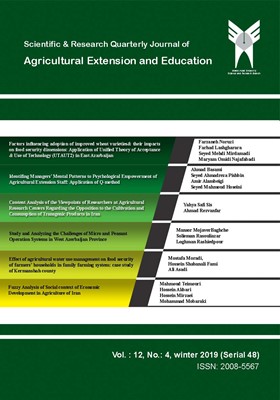تأثیر مدیریت مصرف آب کشاورزی بر امنیت غذایی خانوارهای کشاورزان در نظام بهرهبرداری خانوادگی: موردمطالعه شهرستان کرمانشاه
الموضوعات : Agricultural Extension and Education Researchحسین شعبانعلی فمی 1 , مصطفی مرادی 2 , علی اسدی 3
1 - گروه مدیریت و توسعه کشاورزی، دانشکده اقتصاد و توسعه کشاورزی، تهران، ایران
2 - گروه مدیریت و توسعه کشاورزی، دانشکده اقتصاد و توسعه کشاورزی، دانشگاه تهران
3 - استاد دانشکده اقتصاد و توسعه کشاورزی دانشگاه تهران
الکلمات المفتاحية: شهرستان کرمانشاه, مدیریت مصرف آب کشاورزی, نظام بهرهبرداری خانوادگی, امنیت غذایی,
ملخص المقالة :
پژوهش حاضر با هدف بررسی تأثیر مدیریت مصرف آب کشاورزی بر امنیت غذایی در نظام بهرهبرداری خانوادگی در شهرستان کرمانشاه انجام شده است. جامعه آماری پژوهش را کشاورزان آبی کار شهرستان کرمانشاه تشکیل می دهند که تعداد آنها 9656 خانوار بودند. حجم نمونه با استفاده از فرمول کوکران، 217 خانوار تعیین شد که با روش طبقهای با انتساب متناسب انتخاب شدند. روایی پرسشنامه به روش روایی محتوایی با بهرهگیری از نظرات یک پنل متخصصان در زمینه موضوع موردپژوهش (اعضای هیئتعلمی گروه مدیریت و توسعه کشاورزی دانشگاه تهران) و پایایی آن با استفاده از ضریب آلفای کرونباخ تأیید گردید (73/0). برای تجزیهوتحلیل دادههای گردآوریشده از نرمافزار SPSSWin23 استفاده شد. نتایج حاصل از تحلیل مسیر نشان داد که مدیریت مصرف آب کشاورزی بهطور مستقیم و غیرمستقیم از طریق بهبود کیفیت محصول، تنوع تولید، تغییر الگوی کشت، افزایش مصرف تولیدات کشاورزی، افزایش تولید محصول، افزایش بهرهوری نهادهها و افزایش درآمد بر امنیت غذایی کشاورزان تأثیر میگذارد. بهبود مدیریت مصرف آب کشاورزان علاوه بر افزایش تولید و بهره وری نهاده های تولید و ارتقای درآمد کشاورزان، موجب افزایش دسترسی کشاورزان به سبد غذایی متنوع و با کیفیت و در نهایت بهبود امنیت غذایی آنها می گردد.


